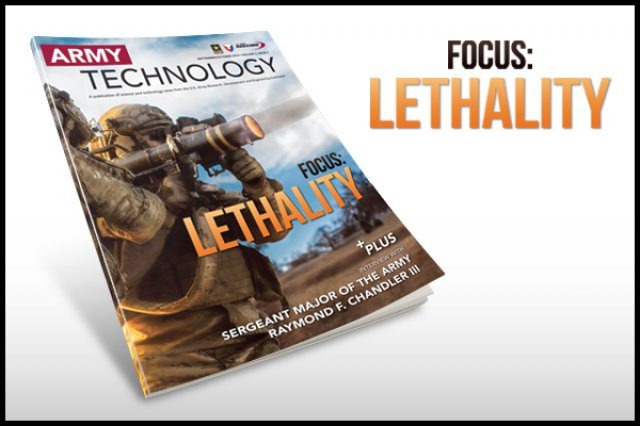The Army of the future may have fewer Soldiers but more lethality thanks to research in precision, scalable effects and improved range.
“Our scientists and engineers are, and have been, redefining the art of the possible to make this enabling technology a reality,” said Dale A. Ormond, director of the U.S. Army Research, Development and Engineering Command. “Our strategy is to build from the Soldier out, equipping our squads for tactical overmatch in all situations.”
In the September/October 2014 issue of Army Technology Magazine, the Army showcases research and development efforts to maintain overmatch.
“The Army has global responsibilities that require large technological advantages to prevail decisively in combat — ‘technological overmatch,'” Army Chief of Staff Gen. Ray Odierno wrote for the Army’s official blog. “Just as Airmen and Sailors seek supremacy in the air and on the seas, Soldiers must dominate their enemies on land. Modernizing, especially as end strength is reduced, is the key to ensuring that the Army’s dominance continues.”
Experts predict an individual Soldier of the future, armed with a 40mm grenade, may have the same lethal effects as current 155mm artillery.
“Lethality is more than just offensive lethality,” said Keith Jadus, acting director of the lethality portfolio for the Office of the Deputy Assistant Secretary of the Army for Research and Technology. “It is the ability to provide protection. Lethality is what protects our Soldiers. It is the capability to reach farther than our adversary, and the ability for Soldiers to hold their ground, protect their ground, and move forward.
Army science and technology research examines affordability, extended range and precision to deliver new capabilities to Soldiers. The Army also seeks a scalable range of effects, both lethal and non-lethal.
“We envision the capability to decrease lethality to reduce collateral damage, or increase lethality tailored to the targets,” Jadus said.
Officials said energetics research also holds the promise of a tenfold increase in range and explosive punch through the use of new materials and chemical compositions.
“Imagine being a commander in the field with 10 levels of scalable lethality,” Ormond said. “Options increase exponentially. A strike need only be as lethal as necessary to accomplish the mission. As our sensors, targeting and associated technologies match our improvements in lethality, commanders will have fine-grained control to minimize if not completely avoid collateral damage.”
Sgt. Maj. of the Army Raymond F. Chandler III, the featured interview for the lethality issue, said the best weapon in the Army is still the U.S. Soldier.
“He or she is also the most precise weapon that the Army has, because of a combination of skills, experience and knowledge. A combination of the technology and the Soldier makes us superior on the battlefield, and that’s what makes the Army strong,” Chandler said.
A tanker by background, Chandler said he has seen the evolution of lethality firsthand during his career.
“We can do a lot with the power of the Soldier when it is accurately matched to technology that provides the outcome we want to achieve,” Chandler said. “In addition to lethality, we also need to increase our precision. We have made great strides in precision technologically, but the most precise weapon we have on the battlefield is the American Soldier. It’s the person that makes the final decision to shoot or not to shoot. Combining our Soldier awareness and the technology that is available, we will be even more accurate and more lethal on the battlefield.
Army Technology Magazine is available as an electronic download, or print publication. The magazine is an authorized, unofficial publication published under Army Regulation 360-1, for all members of the Department of Defense and the general public.










